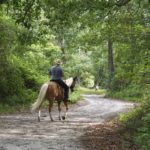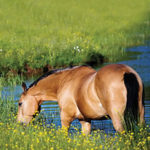Ah, trail riding. Whether it’s a half-hour hack around your own place, a day ride with friends, a group camp-out weekend in the mountains or at the beach, or a multi-day outing in the backcountry, this type of horseback fun is supposed to be just that–fun. But, no matter what version of ?let?s hit the trail? sounds appealing to you, your ride won?t be much fun if you end up unsafe, uncomfortable, or greatly inconvenienced.

That’s where knowledge of some tested tips and tricks comes in handy. We canvassed trail-riding readers, plus Horse & Rider’s own experienced trail hands, to bring you 50 good ones.
Five Must-Take Items
1. Water. Even if you don’t get thirsty enough to drink it, you never know when you might need water for cooling down an overheated horse or rider, or for rinsing out a wound. Tip: For an always-cold drink, drain the top inch from a full plastic water bottle, then freeze it until the remaining water becomes ice. It?ll thaw gradually during your ride, with the unthawed portion keeping the water cold.
2. Rain gear. The unwritten rule about whether to take rain gear on a ride: If you have it, the sun will shine. If you don’t have it, it’ll rain! A storm can blow in when you least expect it, especially in high country. And few things will leave you more miserable than to be soaked to the skin with miles yet to ride. Tip: If you don’t want to invest in, nor carry, a full-length rain slicker, tuck an inexpensive plastic poncho–or even a large heavy-duty leaf bag–in your saddlebag. The latter can be made into makeshift rain gear, and has many other potential uses as well.
3. Sharp pocketknife or folding multi-tool. Whether used to free a rope-entangled horse or to pick your horse’s feet, this is a don’t-leave-home-without-it item. Tip: Carry it securely on your person rather than stuffing it into a bag carried on your horse. That will allow you to access it instantly should an emergency occur–and you won?t be separated from it should you find yourself unhorsed.
4. Food. It’s always smart to have some sort of energy source with you, as you never know when a planned short ride will turn into a long one. Tip: Choose non-bulky foods suitable for carrying on horseback, without need for cooling. Good choices include non-frosted energy bars, jerky, nuts and dried fruit, tuna or salmon in easy-open pouches, or trail mix without chocolate (which has a low melting point).
5. First-aid items. Your list of items can be as simple or detailed as you wish; even a single roll of self-adhesive bandage and few aspirins are worth tucking into your stash of ?just in case? items. Trick: Keep all first-aid items in a single bag, and color-code it for easy recognition during an emergency. Choose a red bag, for instance, or tie a red ribbon or bandanna to the firstaid- kit side of your saddlebags.
10 Items that Could Save the Day
1. Cell phone. And while you’re at it, bring a hand-crank charging unit for it.
2. Coach?s whistle. Use it to sound for help or signal a warning; the piercing sound carries farther than a shout, and takes a lot less wind.
3. Duct tape. From emergency tack repairs to protecting a hoof after shoe loss, this item truly does have 1,001 uses.
4. Baling twine. Like duct tape, this stuff has a list of uses limited only by your imagination and the circumstances in which you find yourself.
5. GPS or compass. Being lost is never fun–enough said.
6. Roll of toilet paper. This tip comes from a search-and-rescue group. Imagine a worst-case scenario, where you’re lost, or someone in your party is gravely ill or injured, and you need to pinpoint your location for rescuers. Use your roll of TP to ?draw? giant arrows on the ground, pointing in your direction. The markings will be visible from the air or from hilltops.
7. Flashlight. Even better: a headlamp, which leaves you with both hands free to do whatever needs doing in the dark.
8. Fire-starting materials. Lighters, waterproof matches, dry paper, or other kindling-type material won?t do you any good if you don’t have them with you when you need them.
9. Space blanket. This is a lightweight blanket designed to reduce heat loss from a person?s body during emergency situations. It consists of a thin sheet of plastic material coated with a metallic reflecting agent that redirects body heat to the wearer. Find one at sporting-good stores, usually for under $5.
10. Plastic shopping bags. Weighing almost nothing, these freebies from supermarkets or other sources have lots of uses. Examples: Slip one over each boot to keep them dry during a cloudburst; create a makeshift water carrier; make a compress holder or bandage cover.
Four Places to Go Before a Trail Trip
1. A tire-service shop. Get your hauling rig?s tires (including the spares) checked for air pressure, tread wear, and so forth. It’s cheap insurance against a ruined trail trip. Get your brakes looked at while you’re there.
2.?A lube-oil service center. Ditto on cheap insurance.
3. An outdoor store. With your comforts and ?what-ifs? in mind, stock up on items designed for those venturing out into the great outdoors.
4. A dollar-type store. From extra bandannas to pocket-sized first-aid kits, you can find many trail-handy items at one of these emporiums.
Five Great Google Searches
Why start from scratch when you don’t have to? A Google search of certain topics brings up all sorts of make-life-easier info. A few faves:
1. camping list
2. camping recipes
3. horse trails
4. outdoor survival
5. cooling fabric
Seven Keep-Cool Tricks
1. Soak a bandanna in cold water, then tie it loosely around your neck. The back of your neck acts as a sort of body thermostat, and the cooled fabric helps regulate it.
2. Carry a battery-operated personal fan. Accustom your horse to the slight whirring sound before you use the unit from the saddle.
3. Tie a thick bathing sponge to a piece of cord long enough to reach the ground from the saddle. At water crossings, drop the sponge to soak it. Then, for evaporative cooling, pull it up and squeeze water onto your or your horse’s neck.
4. Block the sun. Wear sunblock on exposed areas, including the backs and tips of your ears (and don’t forget to protect your lips, too). And unless you live in an unbearably humid climate, wear clothing that shields the expanses of skin on your arms. You?ll feel considerably less baked at the end of an afternoon ride in a long-sleeved shirt than you would after going bare-armed.
5. Consume cold water at regular intervals. Besides keeping you hydrated, there’s nothing like cold water to keep your body?s core from overheating.
6. Bring a misting bottle, and use it to cool yourself from the saddle. This tip works best for those in an arid climate, where evaporation takes place quickly
7. Cover your head. Skipping the hat vs. helmet debate for now, we’ll just remind you that a bare noggin is a sun-cooked one.
Three Hints for Your Green Horse
1. Pair him up with a veteran trail horse–preferably a horse he already knows. Your green guy will learn from and feel more secure with his more experienced buddy, especially if you must negotiate such potentially scary obstacles as water or bridges.
2. Talk little, so you can ride attentively and well. Your green trail horse needs as much confident guidance from you as he can get, and you’ll be best prepared to ride him effectively if you aren?t distracted by conversation.
3. Keep his initial outings from being marathons. Don?t make his first trail rides so long that they exhaust him, mentally or physically
Five Tricks to Thwart Post-Ride Pains
1. Avoid wearing new or starched jeans. Those stiff seams won?t be your friends by the end of your ride.
2.Pad your seatbones. Try a gel-filled or sheepskin saddle cover, or padded equestrian undershorts.
3. Place large adhesive bandages over the saddle-contact area of your knees. It’s a super-simple way to prevent sores from chafing.
4. Lengthen your stirrup leathers a notch or two. It reduces stress on your knees.
5.Get support where you need it. Wear a back or knee support made for riders, for example.
Seven Risks You Can Avoid
1. Riding alone. The risk: If anything happens to you or your horse, there’s no one to aid you or go for help.
2. Leading your horse over an obstacle. The risk: He could knock down and trample you if he jumped to follow you.
3. Running from a menacing dog or other animal. The risk: Your horse’s prey-animal instincts could activate, and panic him.
4. Dismounting on the downhill side of a steep trail. The risk: If your horse slips or slides, he could fall on you.
5. Riding across footing you can’t see. The risk: Thick underbrush can conceal holes, wire, and other hazards; murky water can hide bogs or debris.
6. Riding with a tiedown. (The risk: Without full use of his neck for balance, your horse may not be able to save himself during a fall.
7. Riding during hunting season. The risk: Your horse could be mistaken for game, or you could end up in the path of a stray bullet.
Four Good Earth-First Practices
1. Carry a small trash bag and pack litter out when you find it. As for your own trash–need we say more?
2. When on an established trail, ride single-file without cutting new switchbacks. This reduces overall wear.
3. Spread out when in an open area without a noticeable trail. This disperses the impact of multiple horses.
4.Water your horse only in established stock-watering areas. Steer clear of undisturbed shores and creek edges.





